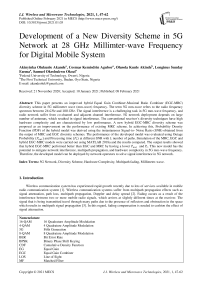Development of a New Diversity Scheme in 5G Network at 28 GHz Millimter-wave Frequency for Digital Mobile System
Автор: Akinyinka Olukunle Akande, Cosmas Kemisdrin Agubor, Olusola Kunle Akinde, Longinus Sunday Ezema, Samuel Okechukwu Okozi
Журнал: International Journal of Wireless and Microwave Technologies @ijwmt
Статья в выпуске: 1 Vol.11, 2021 года.
Бесплатный доступ
This paper presents an improved hybrid Equal Gain Combiner-Maximal Ratio Combiner (EGC-MRC) diversity scheme in 5G millimeter wave (mm-wave) frequency. The term 5G mm-wave refers to the radio frequency spectrum between 24 GHz and 100 GHz. The signal interference is a challenging task in 5G mm-wave frequency, and radio network suffer from co-channel and adjacent channel interference. 5G network deployment depends on large number of antennas, which resulted in signal interference. The conventional receiver’s diversity techniques have high hardware complexity and are characterized by low performance. A new hybrid EGC-MRC diversity scheme was proposed as an improvement on the performance of existing MRC scheme. In achieving this, Probability Density Function (PDF) of the hybrid model was derived using the instantaneous Signal-to- Noise Ratio (SNR) obtained from the output of MRC and EGC diversity schemes. The performance of the developed model was evaluated using Outage Probability 〖(P〗_out) and Processing time (P_t) at different SNR with L number of paths. Simulation of the MRC, EGC and hybrid EGC-MRC models were carried out using MATLAB 2018a and the results compared. The output results showed that hybrid EGC-MRC performed better than EGC and MRC by having a lower P_out and〖 P〗_t. This new model has the potential to mitigate network interference, multipath propagation, and hardware complexity in 5G mm-wave frequency. Therefore, the developed model can be deployed by network operators to solve signal interference in 5G network.
5G Network, Diversity Scheme, Hardware Complexity, Multipath fading, Millimeter-wave
Короткий адрес: https://sciup.org/15017666
IDR: 15017666 | DOI: 10.5815/ijwmt.2021.01.05
Текст научной статьи Development of a New Diversity Scheme in 5G Network at 28 GHz Millimter-wave Frequency for Digital Mobile System
Published Online February 2021 in MECS DOI: 10.5815/ijwmt.2021.01.05
Wireless communication system has experienced rapid growth recently due to lots of services available in mobile radio communication system [1]. Wireless communication systems suffer from multipath propagation effects such as signal attenuation, path loss, multipath propagation, Doppler and delay spread [2]. Fading occurs as a result of the interference between two or more mobile radio signals, which arrives at slightly different times at the receiver. The signal that is being transmitted travel through many paths due to the presence of reflectors and obstruction in the space which results in multipath signal propagation [3]. In this regard, fading compensation is needed to cushion the effect of signal attenuation.
|
Nomenclature 16-QAM 4-QAM 5G 8-QAM BER BPSK CDF EG EGC LOS MF |
16 Quadrature Amplitude Modulation 4 Quadrature Amplitude Modulation Fifth Generation 8 Quadrature Amplitude Modulation Bit Error Rate Binary Phase Shift Keying Cumulative Density Function Equal Gain Equal Gain Combiner Line of Sight Matched Filter |
|
MIMO |
Multiple Input Multiple Output |
|
MR |
Maximal Ratio |
|
MRC |
Maximal Ratio Combiner |
|
NLOS |
Non-Line of Sight |
|
P t |
Processing Time |
|
|
Probability Density Function |
|
P out |
Outage Probability |
|
QAM |
Quadrature Amplitude Modulation |
|
QPSK (4-PSK) |
Quadrature Phase Shift Keying |
|
RF |
Radio Frequency |
|
SC |
Selection Combining |
|
SC-EG |
Selection Equal Gain |
|
SC-MR |
Selection Maximal Ratio |
|
SER |
Symbol Error Rate |
|
SIMO |
Single Input Multiple Output |
|
SNR |
Signal-to-Noise Ratio |
|
TC |
Threshold Combining |
|
TWDP |
Two Wave With Diffuse Power |
Diversity schemes are the method normally deployed at the receiver to combine multiple copies of the signal in the channel to obtain a single improved radio signal that enters the receiver [4]. The multiple signals from the channel are combined using diversity technique to obtain more reliable output signal [5]. The most popular and frequently used fading channel models in mobile communication systems are Rayleigh, Rician and Nakagami [6]. Rayleigh fading is mostly applicable where no line of sight (NLOS) exists. The Rayleigh fading distribution is mostly used to model the time varying nature of the received signal. The Rician distribution is observed where line of sight (LOS) exist between the transmitting antenna and the receiving antenna in the communication system [7].
The existing diversity combining scheme mostly used in signal prediction are Maximal Ratio (MR) Combining, Threshold Combining (TC), Selection Combining (SC), and Equal Gain (EG) Combining. The most commonly used hybrid techniques are Selection-Maximal Ratio (SC-MR) combining and Hybrid Selection-Equal Gain (SC-EG) combining [8]. It was reported that the MRC combiner performed better compared to other methods, but suffered hardware complexity. Signal reliability is very important in digital signal communication system. The use of multiple antenna is a good method to reduce the number of drop calls and loss connections [9].
However, additional hardware circuitry is needed with multiple filters in antenna diversity schemes [10]. This is a drawback on existing combining techniques. Multiple Input Multiple Output (MIMO) technology allows multiple users to share the same network resources simultaneously. Massive MIMO is one of the key enabling technology of 5G’s network extremely fast data rates. This massive MIMO group antennas together at both transmitter and the receiver to provide high spectral and energy efficiency [11]. Beamforming is the ability of the base station to adapt the radiation pattern of the antenna. Beamforming helps the base station to find a suitable route to deliver data to the user, and it also reduces interference between nearby users [11].
The millimeter-waves cannot penetrate through obstacles and do not propagate to longer distances due to a shorter wavelength. Beamforming helps to send concentrated beams towards the users. Again, beamforming helps user to receive a strong signal without interference with other users in the channel [12]. The massive MIMO antenna interference becomes more challenging to manage in the dense environment. Hence, interference in fifth Generation (5G) mobile network is very crucial for millimeter-wave frequency bands due to the deployment of large number of antenna.
Millimeter-waves are frequency between 30 GHz to 300 GHz, and it is called millimeter-waves because its length varies from 1 to 10 mm. Millimeter-waves can provide bandwidth ten times more than that of the entire 4G cellular band. The mm-wave has small wavelength, and are not suitable for long distance propagation. The term 5G mm-wave refers to the radio frequency spectrum between 24 GHz and 100GHz, which have a very short wavelength. This mm-wave technology aims to increase the amount of bandwidth available, since low frequencies are congested with TV and radio signal, as well as 4G LTE network at 800 to 3000 MHz [13]. Millimeter-waves cannot penetrate buildings and obstacles, and they tend to get absorbed by rain. This is perhaps the most common issues cited with upcoming 5G networks. Most building materials, such as cement and brick, attenuate and reflect very high frequency signals with a big enough loss.
The high-frequency 5G mm-wave signals don’t travel far in mobile communication channel, but it will bounce around them to ensure a decent signal [14]. However, massive MIMO and beamforming ensure that strict LOS is not a requirement to make use of millimeter-wave. 5G network mm-wave cannot penetrate thick object and foliage, which resulted in interference, power loss, and signal attenuation [15]. Hence, the signal bounce around object to reach its destination. The developed EGC-MRC model combines signal from many path and equalize them to obtain a robust signal power at the receiver.
In the 5G wireless network, mm-wave has a huge and potential frequency band available to fulfil the demand of high data rate, however, different challenges seem to make it more difficult. The mm-wave is one of the enabling technology that is being explored in 5G mobile network [11]. This mm-wave are easily absorbed by foliage and building, and will require many closely spaced transceiver stations to serve different network users. The deployment of large number of antennas in mm-wave bands causes interference, and multipath fading due to signal obstruction along its paths, whcih resulted to signal degradation [14].
The objective of this paper is to develop an appropriate model to solve signal interference and hardware complexity in 5G network. The Probability Density Function (PDF) of the hybrid model was derived using instantaneous Signal-to- Noise Ratio (SNR) obtained from the output of MRC and EGC diversity schemes. This model is different from existing models, for the fact that it will help to eliminate interference and hardware complexity in the course of implementing diversity combiner at the receiver. The outage probability and processing time were used to evaluate the accuracy of the new hybrid model. The Quadrature Phase Shift Keying (QPSK) and Quadrature Amplitude Modulation (QAM) scheme was deployed with Hybrid EGC-MRC combiner at the receiver with single Radio Frequency (RF) chain and filter to obtain quality and non-overlapping signal at the receiver. The online binary number was generated to carry out computer simulation using MATLAB 2018a software for different signal paths and modulation techniques. This is because the real 5G network data is not available at the time of carry out this research.
The new developed hybrid model with a significant improvement and good performance over the conventional models is an interesting contribution presented in this paper. Another contribution is the use of single filter and RF chain resulting in reduced hardware complexity unlike existing models. The hybrid model show better performance in 5G mm-wave frequency with reduced outage probability and lower processing time. Therefore, the developed model has the potential to mitigate signal interference, multipath fading, and power loss in 5G network. This ability to obtain improved hybrid model with better performance compared to existing models is the major contribution of this work. Organization of the paper starts with section 1, which is the introduction followed by literature review in section 2. Formulation of the system model, mathematical expression for new hybrid scheme, and simulation parameters are contained in sections 3, 4 and 5, respectively. The results are discussed in section 6, while section 7 is the conclusion.
-
2. Literature Review
-
3. System Model
Authors in [16] proposed a hybrid of SC- MRC scheme as new diversity technique over Two Wave with Diffuse Power (TWDP) in Rayleigh fading channel. The proposed model reported to be good, but with high hardware complexity and noise interference. In [2], the analysis of SC-MRC as hybrid diversity scheme over Nakagami communication fading channel was presented. The results show that when number of paths or users increases, the outage probability value also increase, which may be as a result of signal interference. The authors in [17] discussed the Performance evaluation of different diversity scheme in Rayleigh communication channel. It was found that MRC performed better than both SC and EGC diversity combiners.
Also, Authors in [2] proposed MRC-SC as a hybrid diversity method in Rayleigh fading environment. The results show that MRC-SC scheme provide a better performance compared to Selection Combining (SC), but suffers high hardware complexity. Author in [3] worked on the review of hybrid diversity techniques over various fading channels. It was reported that most of the existing models suffer signal interference and cannot solve the problem of multipath propagation in mobile radio channel.
In [7], the comparative analysis of different diversity scheme namely SC, MRC, EGC, and their performance over Rayleigh channel with BPSK modulation scheme was investigated. The results show that MRC gave better performance than SC and EGC diversity techniques, but with increase in Signal to Noise Ratio. A similar result of the performance MRC over EGC and SC was reported in [18]. The investigation of outage probability of dual receiver over Rician communication channel was also carried out in [19]. The results show that the outage probability of EGC and SC is higher compared to MRC combiner when the number of path increases.
The authors in [20] proposed a simple hybrid diversity scheme with Binary Phase Shift Keying (BPSK) modulation scheme for Single Input Multiple Output (SIMO) system in Rayleigh fading environment. The results show that at higher bit rate, when the transmitted bit increases, the model suffers from interference and high complexity, which may lead to increase in cost.
In [21], the comparative analysis of diversity schemes in SIMO multicast wireless network in the presence of diversity and without diversity combiner was reported. The results show that MRC diversity technique is good for multicast communication network system, but suffers high level of interference and hardware complexity.
The above mentioned network impairment prompts the necessity to develop a suitable model for signal transmission in 5G mm-wave frequency. The study proposed EGC-MRC as a new hybrid diversity scheme in Rayleigh fading environment. This scheme, which has not been proposed in previous reviewed works was evaluated using outage probability (P01tt) and signal processing time (Pt) . Therefore, with the deployment of the hybrid EGC-MRC scheme in 5G network at 28 GHz mm-Wave frequency, the proposed hybrid model has the capability to mitigate interference, signal loss, and multipath propagation.
The deployment of large number of antennas in 5G network for indoor and outdoor propagation within small distance always result in signal interference and multipath propagation in Raleigh fading channel. A new model was designed to mitigate these channel impairments. This hybrid model consists of three EGC combiners whose outputs are fed into the input of the MRC combiner. The random generated data was modulated using 4-PSK and 16-QAM. The base band signal is received by M number of antennas of the EGC diversity combiner branch. These M number of the signal from the branches of each EGC receiver with equal gains and acceptable signal level are combine to give improved signal values with equal weight. Then the signal from L number of EGC are fed into MRC to combine only the signals above the set threshold with maximum value of SNR. The resultant robust output from EGC-MRC hybrid diversity combiner is passed through single RF chain and single MF filter to the receiver. The proposed hybrid model is presented in Fig.1.
EGC-MRC
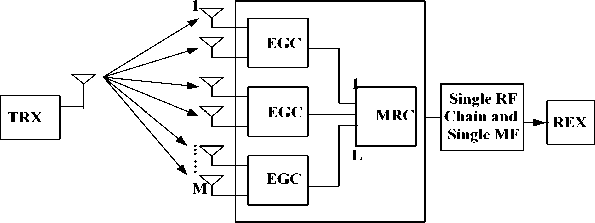
Fig. 1. The Proposed model for the hybrid MRC-EGC combiner
Considering the transmitted signal received by a receiver with M antennas and L EGCs scheme in a Rayleigh fading environment. The output instantaneous SNR of EGC combiner is given by [17] as:
„ . -7л.
„ л - Ут 1 е 7
Y EGc (Y t )- Fr(m)
Where yEGC (yt) is the output instantaneous SNR of EGC, y is the average SNR of received signal, y is the SNR of received signal of the EGC, y(m) is the gamma function, and m is the number of signal paths.
-
3.1. Mathematical Analysis of PDF and Pout for EGC
-
3.1.1. Probability Density Function of EGC
The close form expression was obtained in terms of probability density function and outage probability for EGC combiner.
The Probability Density (PD) function of the output SNR of the EGC diversity combiner is given by [22] as;
-
1 — 2=^
PDFEGC(yt) - — e 7=» + 4п e 7av * [l(yt,yap)](2)
Yav where,
[Kyt/Уа»)] - ("^—1 - ОТ),(3)
\ 2(YavYty2 Yav Yav/
-
уаг, is the average SNR of the EGC combiner and yt is the instantaneous SNR of the output of the EGC. Substituting equation (1) into equation (2) gives;
7/-ym-1e /у у 2 Y£(m)
PDF EGc (y t ) - — e 7av +D(my) *A(y, ym] (4)
Yav where,
-V/-ym-1e /у
Уг(т)
[D(my)] = уп е v™
А(у, гт) =
^ 2^Y avJ
ym-l£
- Y/-' • ZY
Yr(m)
_
) ’
/ ут-1е У/у \2^
_Fr(m^ Y av \ Y av /
-
3.1.2. Outage Probability of EGC
The Outage Probability(Pout) for EGC is given as the integral of the equation (4) by [22, 23] as;
P out = J0Y PDFEGC(Yt)dY (7)
Substituting equation (4) into (7) results to;
'i-
Ym-1e /y v 1 Y г(т)
P out(EGC) J o е ' Yav + [D(my) * A(uk)]dy (8)
o Yav where, yo is the set threshold value, and у is the SNR of received signal of the EGC
-
3.2. Mathematical Analysis of PDF and Pout for MRC
-
3.2.1. Probability Density Function of MRC
The close form expression was obtained in terms of probability density function and outage probability for EGC combiner.
The transmitted signal received by L-branch MRC scheme instantaneous SNR at the output of the diversity combiner is given by [17];
V/-
Yl-1exp /v
y mrc = y I (1-1)
where ymTC is the output instantaneous SNR of the MRC, I is the number of branches, and у is the average SNR of the received signal (MRC). The Probability Density Function of MRC (PDFMRC) is given by [24, 25];
PDFMR c =
Ymrc^ 1
(i-1)!Y av Z
ехр(_^)
V Y av /
Substituting equation (8) into equation (10) results to;
-
3.2.2. Outage Probability of MRC
The integral of the Outage Probability P(out) for MRC is given as;
P out = J0Y PDF mrc (y t )dy (12)
Substituting equation (11) into equation (12) produces outage probability of MRC;
P out (MRc)
/ yl 1exp /y\ / ,-
( Y l (l-i) ) I y— f XE —У \
= 1 r . / exp^^ dy
J 0 (l-iy.Yav1 I YavI '
where, y0 is the set threshold and y the SNR of received signal.
4. The Mathematical Expressions for New Hybrid Scheme
The mathematical expressions for the new hybrid EGC-MRC was achieved using the Probability Density Function (PDF) of EGC and MRC diversity combiner. Thus, the PDF of the new Hybrid model is presented in equation (14) as:
PDFEG c/MRc (y t ) = PDFEG c (y t ) * PDF MRc (y t )
With the substitution of equations (3) and (8) into equation (11) to produced new hybrid model given in equation (15). This new hybrid model was developed from existing EGC and MRC models. The performance of the developed model was evaluated using outage probability and signal processing time. The model is very unique with better, and more accurate result compared to the existing models.
-y/- ym-1e ly
- ? У r ( m)
PDF MRc-EGc (y t ) = —e Yav + [D(my) * A(y, rm)] * [B(k,y[)^ (15)
Y av
where:
B(k,yl)
/ yl 1eXp /y
I y l (l-l)
(l-1)!Y av l
)
l-l
exp
(yl 1exp /y\ yl (l-i) |
Y av I
yEGc (yt) is the instantaneous SNR output of the EGC, and yMR c (yt) is the instantaneous SNR output of the MRC
-
4.1. Performance Metrics for MRC-EGC Receiver
-
4.1.1. Outage Probability
-
4.1.2. Processing Time
The Outage Probability(P0Ut) and Signal Processing Time (Pt) are the metrics used to evaluate the performance of the proposed hybrid model in fading environment.
This is the probability that output PY (y) of the SNR will fall below a threshold value (y0) is given by [17, 18];
P out = I 0Y0 P y (y)dy (17)
Substituting equation (8) and equation (13) into equation (17), the outage probability of the new hybrid model is presented in equation (18) as:
P out(MRc-EGc) = I0Y0 PDF egc (Y t ) * PDF mrc (y t ) dy (18)
where, y0 is the set threshold value, PDFEGc(yt) is the PDF of EGC scheme and PDFMRc(yt) is the PDF of MRC scheme.
Processing time is the time taken (in seconds) to complete simulation process when the signal propagates from source to the receiver. Signal processing time depends on the number of the hardware devices employed in the system design.
-
5. Simulation Parameters
The simulation of the MRC, EGC and hybrid EGC-MRC models were carried out using MATLAB R2018a software tool. It provides an interactive environment and low cost compared with the field test measurements. The
-
6. Results and Discussion
Hybrid EGC-MRC diversity scheme has been developed and simulated using the appropriate 5G network parameters. The conventional EGC and MRC schemes were analytically combined to produce new hybrid EGC-MRC diversity combiner. The Rayleigh fading channel was adopted since there are many obstructions such as trees, building, foliage that scatter the radio signal in the communication channel and create multipath fading. The Outage Probability (Pout) and Processing time (Pt) results were obtained for EGC, MRC and Hybrid EGC-MRC at different level of SNR and 28000 MHz frequency band.
simulation was carried out using randomly generated binary data format using 4-PSK and 16-QAM as modulation schemes in 5G network at 28 GHz mm-wave frequency. The network simulation parameters are given in Table 1.
Table 1. Network Simulation Parameters
|
Parameters |
Variables |
|
Modulation |
BPSK (2-PSK), 4-PSK, 8-PSK, 16-QAM |
|
Channel |
Rayleigh |
|
No of paths (L) |
2,3 |
|
Carrier Frequency Noise LOS Component (k) |
28000 MHz AWGN 3 |
|
SNR |
2 dB - 10 dB |
|
Data length (Set threshold) Y 0 |
10,000 2dB |
|
Base Station power |
1watts |
Fig. 2 shows the comparative plot of Pout against different values of SNR. At L = 2 and 4PSK (QPSK) modulation scheme, the Pout values for EGC were 0.62 dB, 0.35 dB, 0.28 dB, 0.23 dB, and 0.20 dB at SNR of 2, 4, 6, 8, and 10, respectively, while the corresponding values of Pout for MRC were 0.35 dB, 0.19 dB, 0.14 dB, 0.12 dB, and 0.10 dB. The Hybrid EGC-MRC shows a better performance compared to EGC and MRC with Pout values of 0.22 dB, 0.07 dB, 0.04 dB, 0.03 dB, and 0.02 dB at different SNR. The Pout values of hybrid model reduces with increase in SNR, this means that better signal reached the system destination without any interference.
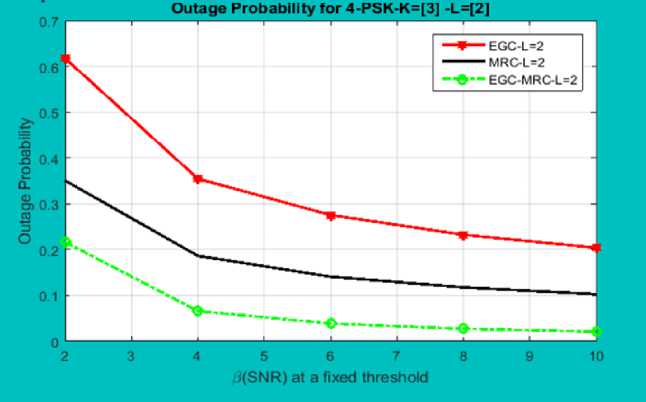
Fig. 2. Outage Probability against SNR for EGC, MRC and EGC-MRC L=2 and 4-PSK Modulation Scheme
Fig. 3 shows plot of Pout against different values of SNR. At L = 3 and 4-PSK modulation scheme, the Pout values for EGC were 0.62 dB, 0.19 dB, 0.11 dB, 0.07 dB, and 0.05 dB at SNR of 2, 4, 6, 8, and 10, respectively, while Pout corresponding values of MRC were 0.31 dB, 0.10 dB, 0.05 dB, 0.04 dB, and 0.03 dB. The Hybrid EGC-MRC is observed to have a better performance compared to EGC and MRC with Pout values of 0.19 dB, 0.02 dB, 0.01 dB, 0.001 dB, and 0.001 dB at SNR of 2, 4, 6, 8, and 10, respectively
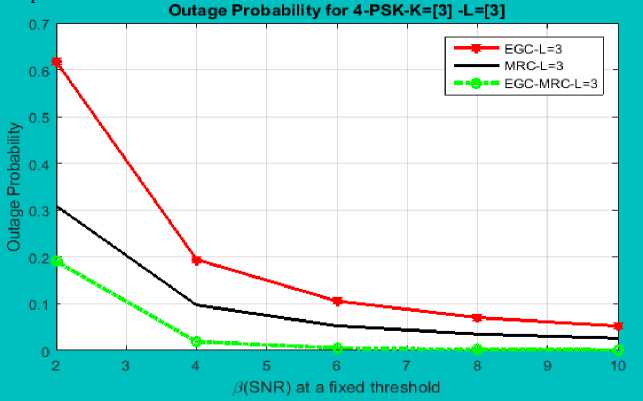
Fig. 3. Outage Probability against SNR for EGC, MRC and EGC-MRC at L=2 and 4-PSK Modulation Scheme
Fig. 4 depicts the plot of processing time plotted in bar chart against SNR at a fixed threshold. . At L = 2 and 4-QAM modulation scheme, the Pt values for EGC were 0.96 sec, 0.96 sec, 0.96 sec , 0.96 sec, and 0.96 sec at SNR of 2, 4, 6, 8, and 10 respectively, while the values of Pt for MRC were 0.90 sec , 0.96 sec , 0.90 sec, 0.96 sec , and 0.96 sec. The Hybrid EGC-MRC performance better than EGC and MRC with Pt values 0.76 sec, 0.76 sec, 0.76 sec, 0.76 sec, and 0.76 sec at different SNR. It can be observed that hybrid model gave lower processing time compare to conventional diversity models, which means the new model has the potential to mitigate the hardware complexity in the communication network.
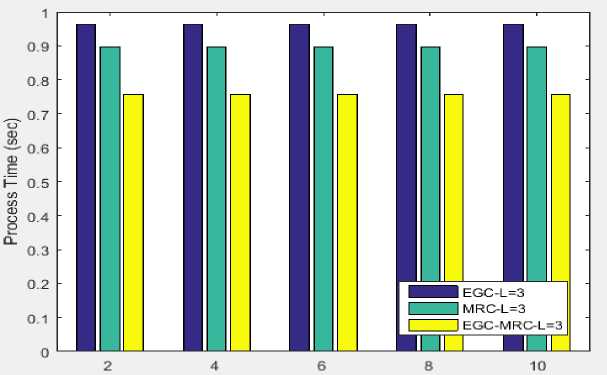
/i(SNR) at a fixed threshold
Fig. 4. Processing Time against SNR for EGC, MRC and EGC-MRC at L=3 and 4-PSK Modulation Scheme
Fig. 5 presents the plot of Outage Probably values against different SNR. At L = 2 and 8-QAM modulation scheme, the values of Pout for EGC were 0.35 dS, 0.18 dS, 0.13 dS, 0.10 dS, and 0.08 dS at SNR of 2, 4, 6, 8, and 10 respectively, while the values of Pout for MRC were 0.22 dS , 0.10 dS, 0.07 dS, 0.05 dS, and 0.04 dS. The Hybrid EGC-MRC show a better performance compared to EGC and MRC with Pout values of 0.07 dS, 0.02 dS, 0.01 dS, 0.01 dS, and 0.01 dS at different SNR. It is observed that there was no signal interference in the channel and hybrid EGC-MRC shows a better performance compared to EGC and MRC.
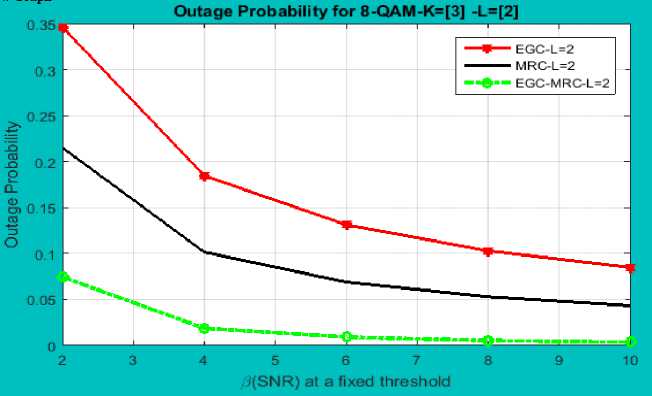
Fig. 5. Plot of Outage Probability against SNR for EGC, MRC and EGC-MRC at L=2 and 8-QAM Modulation Scheme
Fig. 6 presents the plot of P0Ut against different values of SNR. At L = 3 and 8-QAM modulation scheme, the P0Ut values for EGC were 0.35 dB , 0.14 dB , 0.08 dB, 0.06 dB, and 0.04 dB at SNR of 2, 4, 6, 8, and 10, respectively, while the corresponding values of P0Ut for MRC were 0.17 dB, 0.07 dB, 0.04 dB, 0.03 dB, and 0.02 dB. The hybrid EGC-MRC gave a better performance with P0Ut values of 0.06 dB, 0.009 dB, 0.003 dB, 0.002 dB, and 0.001 dB at different SNR. Again, it was observed that probability of outage reduced with increase in SNR without signal interference.
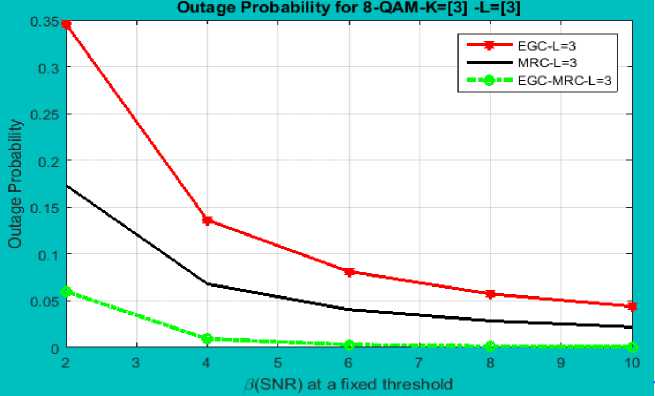
Fig. 6. Plot of Outage Probability against SNR for EGC, MRC and EGC-MRC at L=3 and 8-QAM Modulation Scheme
Fig. 7 depicts Pt plotted in bar chart against SNR at a fixed threshold. At L = 3 and 8-(MM modulation scheme, the Pt values for EGC were 0.86 sec, 0.86 sec, 0.86 sec, 0.86 sec, and 0.86 sec at SNR of 2, 4, 6, 8, and 10, respectively, while Pt values for MRC were 0.63 sec, 0.63 sec, 0.63 sec, 0.63 sec, and 0.63 sec. The hybrid EGC-MRC gave a better performance compared to EGC and MRC with Pt values of 0.52 sec, 0.52 sec, 0.52 sec, 0.52 sec, and 0.52 sec at different SNR. The result shows that hybrid model produce lower processing time compared to existing diversity models. Hence, hybrid model can be deployed to mitigate the effect of hardware complexity in the system.
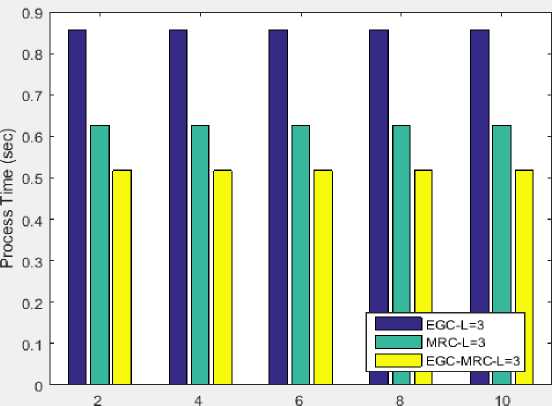
3(SNR) al a fixed threshold
Fig. 7. Plot of Processing Time against SNR for EGC, MRC and EGC-MRC at L=3 and 8-QAM Modulation Scheme
Fig. 8 presents the plot of Outage Probably values against different SNR. At L = 2 and 16-QAM modulation scheme, the Pout values for EGC were 0.35 dB, 0.18 dB, 0.13 dB, 0.10 dB, and 0.08 dB at SNR of 2, 4, 6, 8, and 10, respectively, while the values of Pout for MRC were 0.21 dB, 0.10 dB, 0.07 dB, 0.05 dB, and 0.04 dB. The hybrid EGC-MRC Pout values were 0.07 dB, 0.02 dB, 0.009 dB, 0.005 dB, and 0.004 dB at SNR of 2, 4, 6, 8, and 10, respectively.. It was observed that the Hybrid EGC-MRC shows a better performance compared to EGC and MRC.
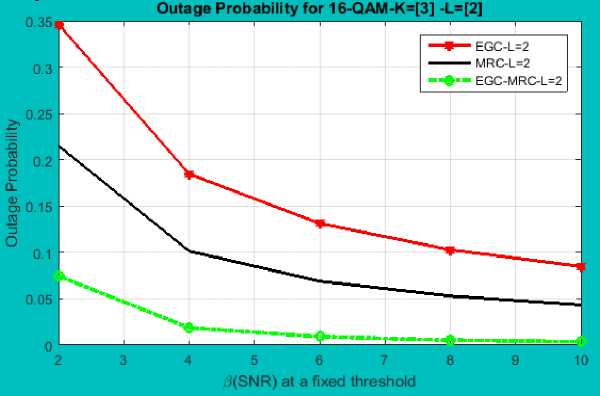
Fig. 8. Plot of Outage Probability against SNR for EGC, MRC and EGC-MRC at L=2 and 16-QAM Modulation Scheme
Fig. 9 depicts the plot of processing time plotted in bar chart against SNR at a fixed threshold. At L = 3 and 16- QAM modulation scheme, the Pout values for EGC were 0.35 dB, 0.14 dB, 0.08 dB, 0.06 dB, and 0.04 dB at SNR of 2, 4, 6, 8, and 10, respectively, while the values of Pout for MRC were 0.17 dB, 0.07 dB, 0.04 dB, 0.03 dB, and 0.02 dB. The hybrid EGC-MRC Pout values were 0.06 dB, 0.009 dB, 0.003 dB, 0.002 dB, and 0.001 dB at SNR of 2, 4, 6, 8, and 10, respectively. The Hybrid EGC-MRC shows a better performance compared to EGC and MRC. It can be observed that hybrid model gave reduced outage probability and processing time with increase in SNR compared to EGC and MRC combiner. Hence, the hybrid EGC-MRC model can be deployed to cushion the effect of multipath propagation in the system.
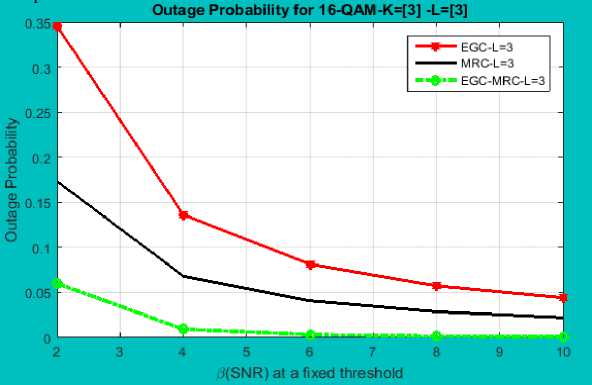
Fig. 9. Outage Probability against SNR for EGC, MRC and EGC-MRC at L=2 and 16-QAM Modulation Scheme
Fig. 10 depicts the plot of processing time plotted in bar chart against SNR at a fixed threshold. At L = 3 and 16- QAM modulation scheme, the values of Pt for EGC were 0.99 sec, 0.99 sec, 0.99 sec, 0.99 sec, and 0.99 sec at SNR of 2, 4, 6, 8, and 10, respectively, while the corresponding values of Pt for MRC were 0.90 sec, 0.90 sec, 0.90 sec, 0.90 sec, and 0.90 sec. The hybrid EGC-MRC gave better result compared to EGC and MRC with Pt values of 0.72 sec, 0.72 sec, 0.72 sec, 0.72 sec, and 0.72 sec at different SNR. The result showed that hybrid model gave lower processing time, which can be deployed to solve the problem of hardware complexity in the system.
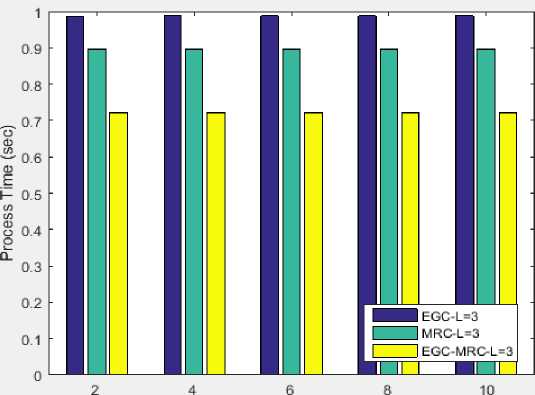
fl(SNR) at a fixed threshold
Fig. 10. Processing Time against SNR for EGC, MRC and EGC-MRC at L=3 and 16-QAM Modulation Scheme
Fig. 11 presents the comparative plot of the total Pout values against SNR. At L = 2, 3 and 8-QAM, the Pout values for EGC is realized as 0.87 dS at L = 2 and 0.69 dS at L = 3, while the corresponding values of Pout for MRC as 0.50 dS and 0.35 dS, respectively. Again, the result of Pout for hybrid EGC-MRC are obtained as 0.13 dS and 0.09 dS at L = 2 and L = 3, respectively.
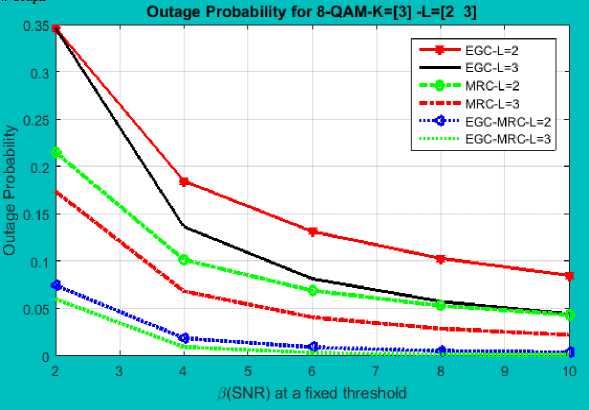
Fig. 11. Outage Probability versus SNR for EGC, MRC and hybrid EGC - MRC at L= 2, 3 and 8-QAM Modulation Scheme
Fig. 12 depicts the comparative plot of the total Pt values against different SNR. At L = 2,3 and 8-QAM, the Pt values for EGC is obtained as 4.47 sec at L = 2 and 4.47 sec at L = 3, while the corresponding values of Pt for MRC as 3.99 sec and 3.99 sec, respectively. Again, the result of Pt for hybrid EGC-MRC are realized as 2.73 sec and 2.73 sec at L = 2 and L = 3, respectively.
о
■u
о
-и
E
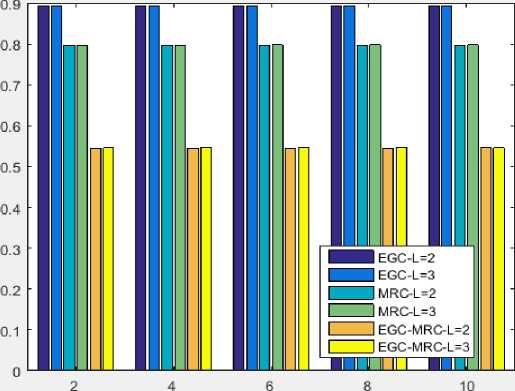
,3(SNR) al a fixed threshold
Fig. 12. Outage Probability versus SNR for EGC, MRC and hybrid EGC - MRC at L= 2, 3 and 8-QAM Modulation Scheme
Fig. 13 shows the comparative plot of the output probability values against SNR. At L = 2,3; and 16-QAM modulation scheme, the total Pout values realized for EGC at L = 2 and L = 3 were 0.87 dB and 0.69 dB respectively, while the corresponding values of Pout for MRC at L = 2 and L = 3 were 0.50 dB and 0.35 dB. The hybrid EGC-MRC Pout values obtained were 0.13 dB and 0.09 dB, respectively.
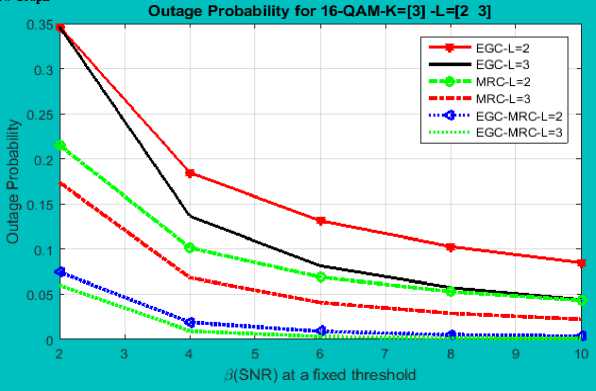
Fig. 13: Outage Probability against SNR for EGC, MRC and hybrid EGC - MRC at L= 2, 3 and 16-QAM Modulation Scheme
Fig. 14 depicts the comparative plot of the total Pt values against different SNR. The Pt(sec) values for EGC when L = 2 and L = 3 were gotten as 4.98 sec and 4.98 sec respectively, while the corresponding values of Pt(sec) for MRC when L = 2 and L = 3 are obtained as 4.52 sec and 4.52 sec. The hybrid system for the Pt(sec) values were realized as 3.76 sec and 3.76 sec, respectively.
The hybrid model demonstrated better performance with reduced Pout and Pt relative to the increase in the number of paths and SNR. The study clearly proved that the hybrid model is suitable to mitigate the problems associated with interference, and multipath propagation in 5G network owing to its reduced signal outage probability and processing time.
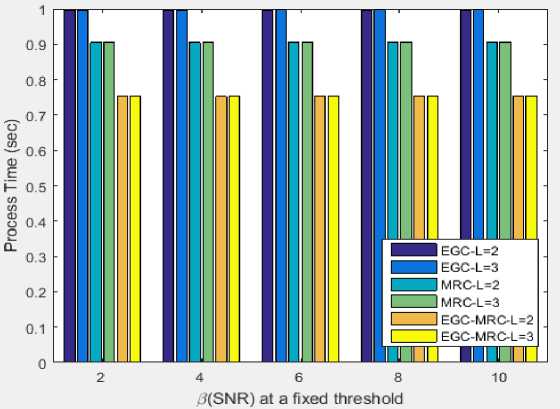
Fig. 14. Processing Time versus SNR for EGC, MRC and hybrid EGC - MRC at L= 2, 3 and 16-QAM Modulation Scheme
Fig. 15 presents plot of the output probability values against SNR. At L = 2,3; and BPSK (2-PSK) modulation scheme, the total Pout values realized for EGC at L = 2 and L = 3 were 3.36 dB and 1.79 dB respectively, while the corresponding values of Pout for MRC at L = 2 and L = 3 were 1.73 dB and 0.90 dB. The hybrid EGC-MRC Pout values obtained were 1.35 dB and 0.74 dB, respectively.
In this case,QPSK, 8-QAM, and 16-QAM gave reduced outage probability values compared to BPSK modulation scheme. Again, the signal interference is observe in the result presented in Figure 15 with BPSK modulation scheme. The developed model cushion the effect of signal interference and multipath propagation in 5G mobile network with the deployment of QPSK, 8-QAM, and 16-QAM modulation schemes. The results shows that BPSK cannot be handle the effect of interference at millimeter wave frequency, while other modulation scheme, such as QPSK, 8-QAM, and 16-QAM have successfully mitigate signal interference and multipath propagation in 5G millimeter wave frequency.
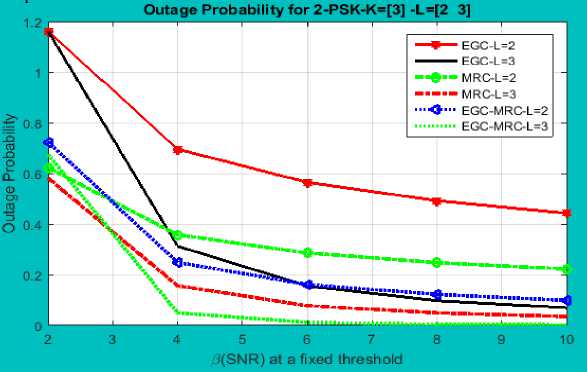
Fig. 15. Processing Time versus SNR for EGC, MRC and hybrid EGC - MRC at L= 2, 3 and BPSK (2-PSK) Modulation Scheme
-
7. Conclusion
In this research, a new hybrid EGC-MRC diversity combining model has been successfully developed and simulated using appropriate 5G network parameters in mm-wave frequency. The developed model was obtained by the combination of EGC and MRC as hybrid diversity combiner. The output of EGC combiner was applied as the input signal to MRC receiver, which was fed into single RF chain and matched filter. Mathematical equation for Probability Density (PD) function of the output signal was obtained for hybrid model, and this was used to derive Outage Probability P01lt expression for the developed model. The P01lt expressions for EGC, MRC, and hybrid EGC-MRC were obtained using output instantaneous SNR. The simulation was carried out using MATLAB 2018a software for different signal paths and modulation techniques. The Outage Probability (P0Ut) values were plotted against the Processing time (Pt) at different SNR between 2 dB to 10 dB. The results obtained showed that the hybrid EGC-MRC performed better than EGC and MRC by having a lower P0Ut and Pt with increase in SNR. It should be noted that 8-QAM and 16-QAM modulation scheme shows better result in terms of P0Ut and Pt compared to BPSK and 4-PSK modulation scheme. The model is very unique one that combined the features of two diversity schemes in Raleigh environment with better, and more accurate result compared to the existing models. The developed model is applicable in mobile communication network. For the fact that existing model suffers hardware complexity and multipath propagation. The hybrid EGC-MRC gave reduced Pt due to reduction in number of filters and overall reduction in complexity. This reduction in hardware complexity is an added advantage in terms of system implementation cost. The 5G network deployment depends on large number of antennas, which resulted in signal interference. This new model is capable of mitigating network interference, signal loss, multipath propagation, and hardware complexity in 5G mm-wave frequency. Therefore, the developed model can be deployed by network operators to solve signal interference and multipath propagation in 5G network.
Список литературы Development of a New Diversity Scheme in 5G Network at 28 GHz Millimter-wave Frequency for Digital Mobile System
- Akande, A. O., Semire, F. A., and Adeyemo, Z. K. Performance Evaluation of the Optimized COST-231-Hata Model for Mobile Radio Communication System in Nigeria, Inter. Journal of Computer Applications, 2017; 173(6): 4-9.
- Dinamani, A., Bijendra, L., Babina, S., Kiran, B., and Shruti, R. Analysis of a Hybrid MRC-SC Diversity Receiver in Rayleigh Communication Channel, Circuits, Controls and Communications (CCUBE), IEEE 2013 International Conference, India, 2013; 1-4
- Singla, M., and Tiwana, S. A Review on Hybrid Diversity Techniques Over Various Fading Channels, Inter., Journal of Engr., Tech., Management and Applied Sciences, 2017; 5(4): 118-120.
- Zhu, B., Wu, L., Cheng, J., and Yang, F. Performance of Diversity Receptions over Arbitrarily Correlated Nakagami Communication Channels, IEEE, Transaction Wireless Communication, 2016; 15(1): 699 -713.
- Nivethika, S., Sreeja, B., Manikandan, E., and Radha, S. Smart and Highly Efficient Mobile Radio Antenna with Low Cost Substrate, Microwave and Optical Tech., Letters, 2018; 60(7): 1798-1803.
- Kanthimathi, M., Anusha, S., and Amutha, R. Modulation Analysis for Differential Amplitude and Phase Shift Keying Modulation Technique, The Inter., J., of Engineering Tech, 2018; 7(1): 418-420.
- Walia, W., and Mahindru, A. Performance Evaluation of Conventional Diversity Combiner Techniques over Rayleigh and Rician Communication Channels, Journal of Computer Engineering (IOSR-JCE), 2014; 16(3): 28-32.
- Hoyong, L., Song, Y., and Sang, P. Performance Evaluation of a Hybrid SC-MRC Diversity Technique in Rayleigh Communication Channel, Proceeding of 13th Inter. Conference on Advanced Communication Tech. (ICACT), Korea, 2011; 1115-1119.
- Selvam, Y., Alsath, M., Elumalai, L., Malathi, K., and Kulandhaisamy, I. A Patch-Slot Antenna Array System with Compound Reconfiguration, IEEE, Antenna and Wireless Propagation Letters, 2018; 17(3): 525-528.
- Subramanian, M., Joshitha, C., Sreeja, B., and Nair, P. Multiport RF MEMS Switch for Satellite Payload Applications, Micro-system Technologies, Springer,2018; 24(5): 2379-2387.
- Robin, C., and Robert A. Massive MIMO Systems for 5G and Beyond Networks-Overview, Recent Trends, Challenges, and Future Research Direction, Journal Sensors, doi:10.3390/s20102753, 2020; 1-35.
- Molisch, A., Ratnam, V., Han, S., Li, Z., and Haneda, K. Hybrid Beamforming for Massive MIMO: A Survey. IEEE Communications Magazine 2017; 55: 134–141
- Kutty, S., and Sen, D., Beamforming for Millimeter Wave Communications: An Inclusive Survey. IEEE Communication Survey Tutorial, 2016; 18(2): 49-973
- Yang, B., Yu, Z., Zhou, J., and Hong, W. Digital Beamforming-Based Massive MIMO Transceiver for 5G Millimeter Wave Communications. IEEE Transactions on Microwave Theory and Technology, 2018; 66: 3403–3418.
- Ali, E., Ismail, M., Nordin, R., and Abdulah, N. Beamforming Techniques for Massive MIMO Systems in 5G: Overview, Classification, and Trends For Future Research, Frontiers of Information Technology & Electronic Engineering, 2017; 18(6): 753-772.
- Sodhi, R., and Khanna, R. Performance Evaluation of Hybrid Diversity Combining Schemes in TWDP Fading Communication Channel, Indian Journal of Science and Tech., 2016; 9(4): 1-6
- Nitika, S., and Deepak, S. Evaluation of Conventional Diversity Combining Techniques over Rayleigh Communication Channel, Inter. Journal of Advanced Research in Computer Science and Software Engr,2012; 2(6): 197-201.
- Agubor, C., Nosiri, O., Ononiwu, G., Atimati, E., and Onyishi, D. Techniques in Performance of Mobile Wireless Communication System: A Review, European Journal of Engineering and Technology, 2015; 3(3): 88-100.
- Pathak, S., and Katiyar, H. Outage Performance of the Diversity Receiver in Rician Communication Channel, Inter. Journal of Advanced Research in Science and Engineering, 2016; 5(4): 685-697.
- Sharma, P., and Buttar, A. Bit Error Rate Improvement over Rayleigh SIMO Channel Using HybridDiversity Combiner Method, Inter., Journal on Recent and Innovation Trends in Computing and Comm., 2014; 2(8): 2355-2358.
- Sayed, R., Shobug, M., and Badrudduza, A. Performance Evaluation of Diversity CombinerScheme in Rician Fading and SIMO Multicasting Wireless Network, Scholars Journal of Engineering and Tech. (SJET), 2016; 4(10): 489-499.
- Goldsmith, A. Wireless Communication System. 2nd ed. New York: Cambridge University Press; 2005
- Rajkumair, S., Natesan, A., and Srinivasain, N. Penta-Band Hybrid Fractal MIMO Antenna System for ISM Applications”, Inter., Journal of RF and Microwave Computer-Aided Engr, 2018; 28(2): 1-13
- Rappaport, T. S. Wireless Communications. 2nd ed. USA: Prentice Hall; 2002.
- Odeyemi., K and Ogunti., E (2014). Performance Comparison Of Beamforming And Multiplexing Techniques Using Smart Antenna Array, I.J. Wireless and Microwave Technologies, , vol.3, pp. 36-50

